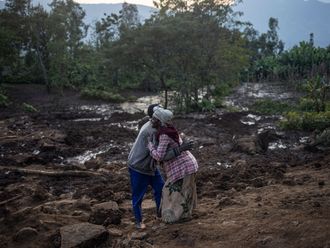OSLO: The world lost tree cover the size of Italy in 2017 as forests were cleared using fire to make way for farms from the Amazon to the Congo Basin, an independent forest monitoring network said on Wednesday.
Tree cover loss, mostly in the tropics, totalled 294,000 sq km (113,000 sq miles) last year, just short of a record 297,000 sq kms in 2016, according to Global Forest Watch, run by the US-based World Resources Institute (WRI).
“Tropical forests were lost at a rate equivalent to 40 football (soccer) fields per minute” in 2017, Frances Seymour, of the WRI, told a news conference at a June 27-28 Oslo Tropical Forest Forum of 500 experts.
Norwegian Environment Minister Ola Elvestuen said the pace of forest losses was “catastrophic” and threatened efforts to slow global warming. Trees soak up carbon dioxide from the air as they grow and release it when they burn or rot.
“Forest destruction is driving climate change,” he said.
Norway has invested about $2.8 billion (Dh10.28 billion) to safeguard tropical forests in the past decade — more than any other rich nation.
Brazil, Democratic Republic of Congo, Indonesia, Madagascar and Malaysia suffered the biggest losses in 2017, Global Forest Watch said, based on satellite data back to 2001.
The study omits, however, how far tree plantings or new growth offset the losses.
“Vast areas continue to be cleared for soy, beef, palm oil and other globally traded commodities. Much of this clearing is illegal,” Seymour said.
Brazil alone lost 45,000 sq km of tree cover, down 16 per cent from a record in 2016. Fires raged in the southern Amazon region of Brazil.
Justin Adams, of the Nature Conservancy environmental group, said only three per cent of public finance for slowing climate change went to natural solutions like forests.
Well-managed forests can be a source of jobs and economic growth, he said.
Tree cover, however, is just one measure of the state of the world’s forests.
The UN’s Food and Agriculture Organization says the loss of forests worldwide slowed to just a net 33,000 sq km a year from 2010-15, with annual losses of 76,000 sq km offset by annual gains of 43,000.
Among differences, the FAO says that a forest where trees are deliberately felled to make way for new plantings is still a forest. Global Forest Watch registers the felling as tree cover loss.
Anssi Pekkarinen, a senior forestry officer of the FAO, said that the FAO method of identifying the underlying land use “gives a much more comprehensive picture on the world’s forests.”










_resources1_16a30b3523c_small.jpg)

